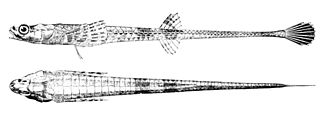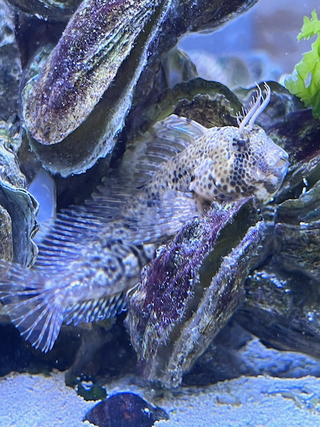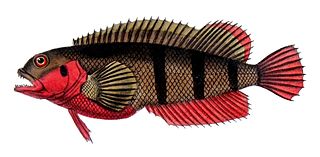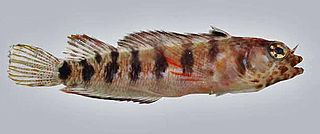
Agonidae is a family of small, bottom-dwelling, cold-water marine fish. Common names for members of this family include poachers, Irish lords, sea ravens, alligatorfishes, starsnouts, hooknoses, and rockheads. They are notable for having elongated bodies covered by scales modified into bony plates, and for using their large pectoral fins to move in short bursts. The family includes about 59 species in some 25 genera, some of which are quite widespread.

Combtooth blennies are blenniiformids; percomorph marine fish of the family Blenniidae, part of the order Blenniiformes. They are the largest family of blennies with around 401 known species in 58 genera. Combtooth blennies are found in tropical and subtropical waters in the Atlantic, Pacific and Indian Oceans; some species are also found in brackish and even freshwater environments.

Threefin or triplefin blennies are blenniiforms, small percomorph marine fish of the family Tripterygiidae. Found in tropical and temperate waters of the Atlantic, Pacific and Indian Oceans, the family contains about 150 species in 30 genera. The family name derives from the Greek tripteros meaning "with three wings".

Blenny is a common name for many types of fish, including several families of percomorph marine, brackish, and some freshwater fish sharing similar morphology and behaviour. Six families are considered "true blennies", grouped under the order Blenniiformes; its members are referred to as blenniiformids. About 151 genera and nearly 900 species have been described within the order. The order was formerly classified as a suborder of the Perciformes but the 5th Edition of Fishes of the World divided the Perciformes into a number of new orders and the Blenniiformes were placed in the percomorph clade Ovalentaria alongside the such taxa as Cichliformes, Mugiliformes and Gobiesociformes.

Sebastes is a genus of marine ray-finned fish belonging to the subfamily Sebastinae part of the family Scorpaenidae, most of which have the common name of rockfish. A few are called ocean perch, sea perch or redfish instead. They are found in the Atlantic and Pacific Oceans.

Pholidae is a family of marine ray-finned fishes, known as gunnels, in the scorpaeniform suborder Zoarcoidei. These are fishes of the littoral zone and are mainly found in North Pacific Ocean, with two species found in the North Atlantic Ocean and Arctic Ocean.

Stichaeidae, the pricklebacks or shannies, are a family of marine ray-finned fishes in the suborder Zoarcoidei of the order Scorpaeniformes. Most species are found in the North Pacific Ocean with a few in the North Atlantic Ocean.

Malacoctenus is a genus of labrisomid blennies native to the eastern Pacific Ocean and the Atlantic Ocean.

Hypsoblennius is a genus of combtooth blennies found in the Pacific and Atlantic Oceans.

Labrisomus is a genus of labrisomid blennies native to the western Atlantic ocean and the eastern Pacific Ocean.

Paraclinus is a genus of labrisomid blennies native to eastern Pacific Ocean and the western Atlantic Ocean.

Starksia is a genus of labrisomid blennies native to the western Atlantic Ocean and the eastern Pacific Ocean. Their typical length is 2 cm (0.79 in) SL. The generic name honours the American ichthyologist Edwin Chapin Starks (1867-1932) of Stanford University for his work on Pacific coastal fishes. As a genus Starksia is distinguished from other labrisomids by their scaled bodies, two obvious soft rays in the pelvic fin and the male's have an intromittent organ which is near to or attached to the first spine of their anal fins, which is also somewhat separated from the fin.
Labrisomus socorroensis, the Misspelled blenny, is a species of labrisomid blenny endemic to the Revillagigedo Islands where they inhabit rocky areas at depths of from extremely shallow waters to 10 metres (33 ft).
Labrisomus xanti, the Largemouth blenny, is a species of labrisomid blenny native to the Pacific coast of Mexico from Baja California to Jalisco. It inhabits shallow waters. This species can reach a length of 17.8 centimetres (7.0 in) TL. The specific name honours the collector of the type, the Hungarian zoologist John Xantus (1825-1894).

Starksia atlantica, the smooth-eye blenny, is a species of labrisomid blenny native to the western central Atlantic Ocean and the Caribbean Sea where it inhabits coral reefs at depths of around 8 metres (26 ft).

Starksia langi, the Lang's blenny, is a species of labrisomid blenny native to the Caribbean coast of Central America, found in Belize, Honduras, and Panama. It is found in shallow waters of usually 3 m (9.8 ft) or less. This species reach a length of 1.7 cm (0.67 in) SL. It is named after Michael A. Lang, Director of the Smithsonian Marine Science Network and Smithsonian Science Diving Program. It is a prey of the lionfish.

Starksia smithvanizi, the brokenbar blenny, is a species of labrisomid blenny native to the Caribbean Sea. It is found on reefs around islands at depths of from very shallow waters to 6 m (20 ft). This species can reach a length of 2 cm (0.79 in) SL. The specific name honours the ichthyologist William F. Smith-Vaniz.

Starksia spinipenis, the phallic blenny, is a species of labrisomid blenny native to the Pacific coast of Mexico from the Gulf of California to Acapulco. It prefers shallow sandy areas with weed growth. This species can reach a length of 5 centimetres (2.0 in) TL. The specific name is a compound noun if spinis meaning "spine" and penis, a reference to the first spine in the anal fin of the males which is elongated and free of the fin membrane and is modified as a copulatory organ, a characteristic of the genus Starksia.
Brockius is a genus of labrisomid blennies from the waters of the eastern Pacific and the western Atlantic where they are associated with reefs and seaweed-covered rocks.
Starksia splendens, the splendid shy blenny, is a species of labrisomid blenny which was described in 2018 from the Cayman Islands. It is one of the blackcheek shy blennies, in the Starksia lepicoelia species complex. This species complex is made up of a number of allopatric cryptic species in the Caribbean which are best separated using mtDNA and the extensive use of underwater photographs.


















